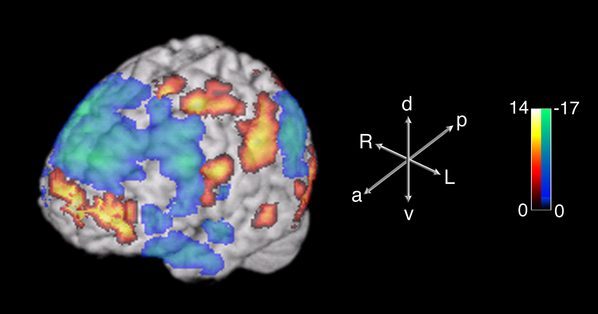Scientists funded by the National Institute on Deafness and Other Communication Disorders (NIDCD) have found that, when jazz musicians are engaged in the highly creative and spontaneous activity known as improvisation, a large region of the brain involved in monitoring one’s performance is shut down, while a small region involved in organizing self-initiated thoughts and behaviors is highly activated.
The researchers propose that this and several related patterns are likely to be key indicators of a brain that is engaged in highly creative thought.
During the study, six highly trained jazz musicians played the keyboard under two scenarios while in the functional MRI scanner. Functional MRI (fMRI) is an imaging tool that measures the amount of blood traveling to various regions of the brain as a means of assessing the amount of neural activity in those areas.

“The ability to study how the brain functions when it is thinking creatively has been difficult for scientists because of the many variables involved,” said James F. Battey, Jr., M.D., Ph.D., director of the NIDCD. “Through some creative thinking of their own, these researchers designed a protocol in which jazz musicians could play a keyboard while in the confines of a functional MRI scanner. And in doing so, they were able to pinpoint differences in how the brain functions when the musicians are improvising as opposed to playing a simple melody from memory.”
The study was conducted by researchers of NIDCD’s Division of Intramural Research. Authors on the study are Charles J. Limb, M.D., who was then a research fellow with NIDCD, and Allen R. Braun, M.D., chief of the division’s Language Section. Dr. Limb is now an otolaryngologist at the Johns Hopkins University School of Medicine and faculty member at the university’s Peabody Conservatory of Music.
The first scenario, called the Scale paradigm, was based on a simple C major scale. Using only their right hand, the volunteers first played the scale up and down in quarter notes, an activity they, as accomplished musicians, had performed many times before. Next, they were asked to improvise, though they were limited to playing quarter notes within the C major scale. “Although the musicians were indeed improvising, it was a relatively low-level form of improvisation, musically speaking,” said Limb.
The second scenario, called the Jazz paradigm, addressed higher level musical improvisation. This paradigm was based on a novel blues melody written by Limb that the volunteers had memorized beforehand. Again, using only their right hand, the musicians would play the tune exactly as they had memorized it, only this time accompanied through headphones by a pre-recorded jazz quartet. When they were asked to improvise, the musicians listened to the same audio background, but they were free to spontaneously play whatever notes they wished.
All of this was accomplished while the musicians lay on their backs with their heads and torsos inside an fMRI scanner and their knees bent upward. The plastic keyboard, which was shortened to fit inside the scanner and which had its magnetic parts removed for safety, rested on the musicians’ knees. A mirror placed over the volunteers’ eyes, together with the headphones, helped the musicians see and hear what they were playing. The resulting fMRI scans recorded the amount of change in neural activity—increases and decreases—between the improvised and memorized versions.
Turning Off ‘the Monitor’
One notable finding was that the brain scans were nearly identical for the low-level and high-level forms of improvisation, thus supporting the researchers’ hypothesis that the change in neural activity was due to creativity and not the complexity of the task. If the latter were the case, there would have been a more noticeable difference between the Scale and Jazz paradigms, since the Jazz paradigm was significantly more complex.
Moreover, the researchers found that much of the change between improvisation and memorization occurred in the prefrontal cortex, the region of the frontal lobe of the brain that helps us think and problem-solve and that provides a sense of self. Interestingly, the large portion responsible for monitoring one’s performance (dorsolateral prefrontal cortex) shuts down completely during improvisation, while the much smaller, centrally located region at the foremost part of the brain (medial prefrontal cortex) increases in activity. The medial prefrontal cortex is involved in self-initiated thoughts and behaviors, and is very active when a person describes an event that has happened to him or makes up a story. The researchers explain that, just as over-thinking a jump shot can cause a basketball player to fall out of the zone and perform poorly, the suppression of inhibitory, self-monitoring brain mechanisms helps to promote the free flow of novel ideas and impulses. While this brain pattern is unusual, it resembles the pattern seen in people when they are dreaming.
Another unusual finding was that there was increased neural activity in each of the sensory areas during improvisation, including those responsible for touch, hearing and vision, despite the fact that there were no significant differences in what individuals were hearing, touching and seeing during both memorized and improvised conditions. “It’s almost as if the brain ramps up its sensorimotor processing in order to be in a creative state,” said Limb. The systems that regulate emotion were also engaged during improvisation.
“One important thing we can conclude from this study is that there is no single creative area of the brain—no focal activation of a single area,” said Braun. “Rather, when you move from either of the control tasks to improvisation, you see a strong and consistent pattern of activity throughout the brain that enables creativity.”
Article: Limb CJ, Braun AR (2008), Neural Substrates of Spontaneous Musical Performance: An fMRI Study of Jazz Improvisation, PLoS ONE 3(2): e1679. doi:10.1371/journal.pone.0001679




Comments